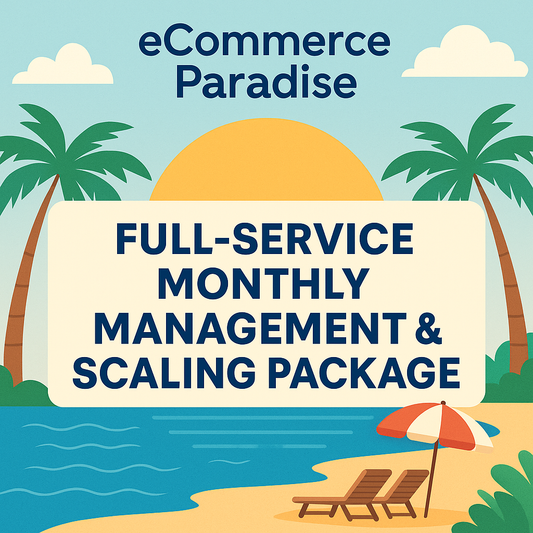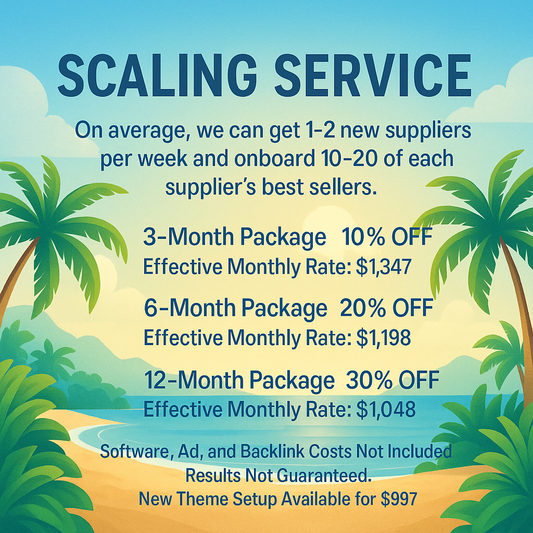
Kickstart Your Success: Understanding Drop Shipping Basics
Hey there, fellow entrepreneurs! Trevor Fenner here, founder of Ecommerce Paradise. If you're reading this, you’re likely dreaming of starting your own ecommerce store or are already deep into your journey. One of the most exciting business models out there is drop shipping, and today we’ll break down the basics to set you up for success.
What is Drop Shipping?
At its core, drop shipping is a fulfillment method where a store doesn't keep the products it sells in stock. Instead, when you sell a product, you purchase the item from a third party and have it shipped directly to your customer. This means you don’t have to deal with inventory or manage a warehouse, which can be a huge relief for anyone looking to ecommerce store build and launch.
How Drop Shipping Works
The drop shipping model involves three main players: the customer, the merchant (that’s you!), and the supplier. Here’s a breakdown of how the process works:
The Customer Places an Order
When a customer visits your online store and finds something they love, they place an order and make a payment.
You Forward the Order to Your Supplier
Once you receive the order, you simply notify your supplier (the company you've partnered with) to fulfill the purchase on your behalf.
Your Supplier Ships the Product
The supplier packs and ships the product directly to your customer. Voila! You’ve made a sale without ever having to touch the product yourself.
Benefits of Drop Shipping
You might be wondering why so many entrepreneurs are jumping on the drop shipping bandwagon. Here are some of the key benefits:
- No Inventory Costs: Because you won’t stock the products, you skip the upfront costs associated with inventory management.
- Flexibility: You can operate your business from anywhere, as long as you have an internet connection.
- Low Startup Costs: You don’t need a lot of cash to get started, making it accessible to anyone who wants to ecommerce store build and launch.
- Wide Product Range: You can offer a large variety of products without worrying about storage space.
Challenges of Drop Shipping
While the drop shipping model offers numerous benefits, it’s not without its challenges. Let’s take a look at a few hurdles you might face:
- Low Margins: Competition can be fierce in the drop shipping world, leading to lower profits. Finding high ticket ecommerce products can mitigate this issue.
- Inventory Issues: Since you won’t manage the inventory, stock levels can fluctuate, potentially leading to customer disappointment.
- Shipping Complexities: If you work with multiple suppliers, your shipping costs and times might vary, complicating the customer experience.
Choosing a Niche
Picking the right niche is arguably the most crucial step in your drop shipping journey. Here are some tips on how to carve out your market:
Target Audience
Understanding your target audience is critical. Who are they? What do they buy? Conduct market research to identify gaps in the marketplace that you can fill.
Trend Spotting
Stay informed about trends in the industry. Tools like Google Trends can help you find what consumers are increasingly searching for.
High Ticket Vs. Low Ticket Products
While low ticket items may seem attractive because of their high sales volume, turning to high ticket ecommerce can potentially yield better profits per sale. Think about the investments your customers are willing to make.
Finding Suppliers
Once you’ve decided on your niche, it's time to find suppliers. Here are some methods to help you source reliable partners:

- Directories: Use supplier directories like SaleHoo, Alibaba, or Worldwide Brands to find trusted suppliers within your niche.
- Google Search: A simple Google search can lead you to suppliers who specialize in the products you're interested in. Be sure to vet them thoroughly!
- Attend Trade Shows: If you have the opportunity, visit trade shows to meet suppliers and see the products in person. This adds an extra level of credibility to your partnerships.
Setting Up Your Online Store
Now that you understand the basics and know how to find suppliers, it’s time to set up your online store. Here's how to get started:
Choose a Platform
Platforms like Shopify are ideal for creating a drop shipping store due to their user-friendly interface and built-in support for dropshipping apps.
Select a Domain Name
Your domain name should reflect your brand and be memorable. Don't rush this step; it’s essential for your brand identity.
Design Your Store
Invest time in your store's design. It should be professional, easy to navigate, and optimized for mobile devices. Use high-quality images and write detail-rich product descriptions to engage visitors.
Install Essential Apps
Consider integrating apps meant for drop shipping management, like Oberlo or Spocket, into your Shopify store for seamless order fulfillment.
Marketing Your Drop Shipping Store
Once your store is up and running, it’s time to turn your attention to marketing. Here are some effective strategies:
Social Media Marketing
Platforms like Instagram and Facebook are excellent ways to showcase your products. Engage with potential customers by posting high-quality images, stories, and engaging content that speaks to your audience's interests.
Email Marketing
Build an email list from day one. Email marketing remains one of the top-performing strategies for ecommerce. Send targeted campaigns to convert visitors into buyers.
Search Engine Optimization (SEO)
Invest time in SEO strategies to ensure your ecommerce store ranks well in search engine results. Optimize your product descriptions, images, and meta tags with keywords like “high ticket ecommerce” to attract organic traffic.
Paid Advertising
Consider running Facebook or Google Ads to boost visibility. These platforms allow you to target specific demographics, making your ad spend more effective.
The Importance of Customer Service
In the fast-paced world of drop shipping, exceptional customer service is vital. Here’s how to stand out:
- Quick Responses: Respond to customer inquiries promptly. Quick service shows that you value your customers.
- Easy Returns: A straightforward return policy minimizes negative experiences and encourages trust in your store.
- Consistent Communication: Keep your customers informed about their orders' status and shipping. Transparency is key to gaining loyal customers.
Monitoring Performance
Track your store's performance regularly to identify what works and what doesn’t. Use tools like Google Analytics to monitor traffic, conversion rates, and customer behavior. This data is invaluable to adjust your strategy for long-term growth.
Final Thoughts on Your Drop Shipping Journey
So, there you have it! By understanding the basics of drop shipping, you’ve laid the groundwork for your successful ecommerce venture. Remember, the journey won’t always be easy, but with determination and strategic planning, you can create a thriving drop shipping business. Keep learning, testing new strategies, and refining your approach. Your success story awaits! Cheers to your entrepreneurial journey!


















